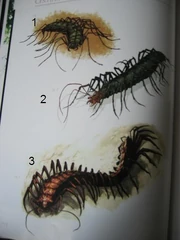
I. illotus (1), I. venefaucus (2), and Omnimatercimex harpeforceps (3)
Skull Island has a number of arboreal tropical centipedes in its jungles that are quite lethal.
Example Species
- Idolon illotus (10-14 inches long): a voracious predator of the high canopy, where it tears along the branches in pursuit of such prey as flizards. Contrasted with the heavyweight centipedes of the jungle floor, I. illotus is a lightly built sprinter. Its lethal venom kills small prey within moments of biting, thus reducing the risk of injury to the hunter.
- Idolon venefaucus (20-24 inches long): an ambusher, hiding amid dense leaves and vines to pounce on prey such as insects, spiders or lizards (like aerosaurs). The predators’ dull gray coloring helps them blend into the shadows, hiding them from both prey and other predators alike. The centipede-eating Skull Island hornbill is immune to their venom.
- Omnimatercimex harpeforceps (30-35 inches long): the largest of the island’s tree-dwelling centipedes, Omnimatercimex prey on the young and defenseless, unguarded bird chicks (such as parrots) or non-avian dinosaur babies, such as of tree-tops. A single dinosaur hatchling can feed the tropical centipede for weeks. Having made a kill, the centipede will eat its way into the carcass, scenting it with a pungent repellant to ward off scavengers and allowing it to consume its prize in peace from the inside out.

